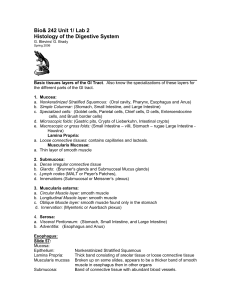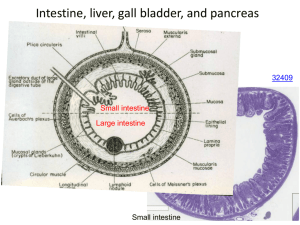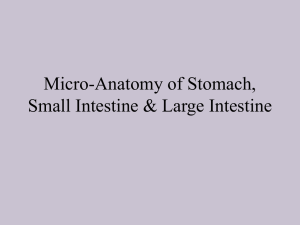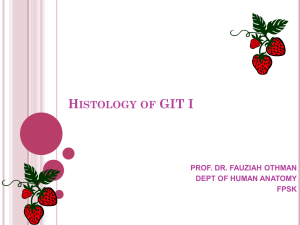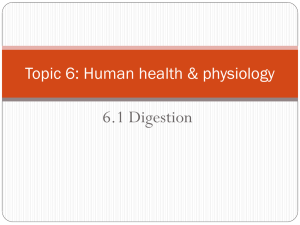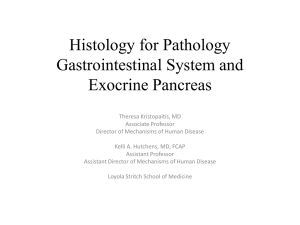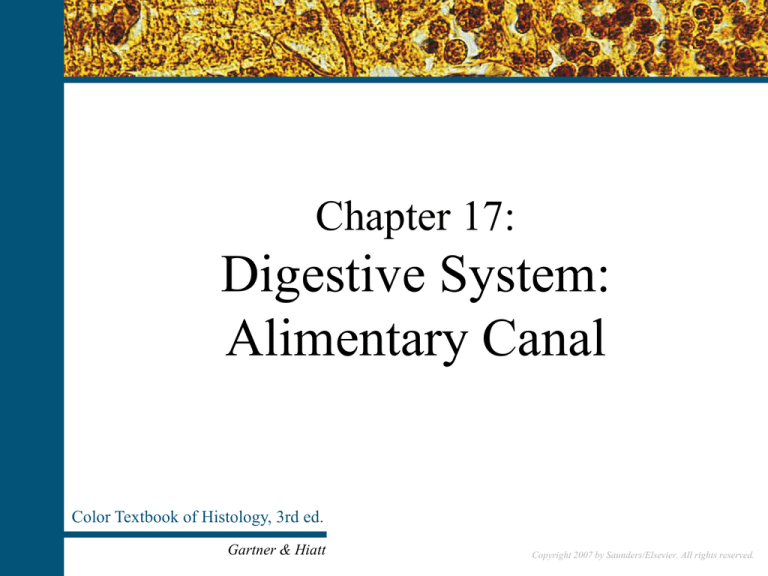
Chapter 17:
Digestive System:
Alimentary Canal
Color Textbook of Histology, 3rd ed.
Gartner & Hiatt
Copyright 2007 by Saunders/Elsevier. All rights reserved.
Copyright 2007 by Saunders/Elsevier. All rights reserved.
Alimentary Canal Overview
The histology of the alimentary canal often is discussed in terms
of four broad layers: the mucosa, submucosa, muscularis
externa, and serosa (or adventitia). These layers are similar
throughout the length of the digestive tract but display regional
modifications and specializations.
The lumen of the alimentary canal is lined by an epithelium,
deep to which is a loose connective tissue known as the lamina
propria. This richly vascularized connective tissue houses
glands as well as lymph vessels and occasional lymphoid
nodules. Surrounding this connective tissue coat is the
muscularis mucosae, composed of an inner circular layer and
an outer longitudinal layer of smooth muscle. The epithelium,
lamina propria, and muscularis mucosae are collectively called
the mucosa.
The mucosa is surrounded by a dense, irregular fibroelastic
connective tissue layer, the submucosa. The submucosa has no
glands except in the esophagus and duodenum; it houses blood
and lymph vessels and Meissner’s submucosal plexus.
Figure 17–1 Alimentary tract. Layer contents are generalized.
The submucosa is invested by a thick muscular layer, the
muscularis externa, responsible for peristaltic activity, which
moves the contents of the lumen along the tract.
The muscularis externa is enveloped by a thin connective tissue
layer that may or may not be surrounded by the simple
squamous epithelium of the visceral peritoneum. If the region of
the alimentary canal is intraperitoneal, it is invested by
peritoneum, and the covering is known as the serosa. If the
organ is retroperitoneal, it adheres to the body wall by its
adventitia.
For more information see General Plan of the Digestive Tract in Chapter 17
of Gartner and Hiatt: Color Textbook of Histology, 3rd ed. Philadelphia, W.B.
Saunders, 2007.
Copyright 2007 by Saunders/Elsevier. All rights reserved.
Esophagus
The lumen of the esophagus, lined by a thick, stratified
squamous nonkeratinized epithelium.
The lamina propria houses esophageal cardiac glands,
which produce a mucoid secretion.
The muscularis mucosae is unusual in that it consists of only a
single layer of longitudinally oriented smooth muscle fibers.
The submucosa of the esophagus is composed of a dense,
fibroelastic connective tissue, which houses the esophageal
glands proper. These tubuloacinar glands produce a mucous
secretion. Meisner’s submucosal plexus is present in the
submucosa.
Figure 17-2 Light micrograph of the esophagus (´17). Note that the lumen is lined by a relatively
thick stratified squamous epithelium (E) that forms a well-developed rete apparatus with the
underlying lamina propria (LP). The submucosa (S) is surrounded by a thick muscularis externa,
composed of inner circular (IC) and outer longitudinal (OL) muscle layers.
The muscularis externa of the esophagus is arranged in two
layers, inner circular and outer longitudinal. However, these
muscle layers are unusual in that they are composed of both
skeletal and smooth muscle fibers. The muscularis externa of
the upper third of the esophagus has mostly skeletal muscle;
the middle third has both skeletal and smooth muscle; and the
lowest third has only smooth muscle fibers. Auerbach’s plexus
occupies its usual position between the inner circular and outer
longitudinal smooth muscle layers of the muscularis externa.
The esophagus is covered by an adventitia until it pierces the
diaphragm, after which it is covered by a serosa.
For more information see Esophagus in Chapter 17 of Gartner and Hiatt:
Color Textbook of Histology, 3rd ed. Philadelphia, W.B. Saunders, 2007.
Copyright 2007 by Saunders/Elsevier. All rights reserved.
Stomach
The stomach, the most dilated region of the alimentary canal,
is a sac-like structure that in the average adult can
accommodate approximately 1500 ml of food and gastric
juices at maximal distention. The bolus passes through the
gastroesophageal junction into the stomach, where it is
processed into a viscous fluid known as chyme.
Intermittently, the stomach empties small aliquots of its
contents through the pyloric valve into the duodenum. The
stomach liquefies the food, continuing its digestion via the
production of hydrochloric acid and the enzymes pepsin,
rennin, and gastric lipase and via production of paracrine
hormones.
The lumen of the fundic stomach is lined by a simple
columnar epithelium composed of surface-lining cells, which
manufacture a thick mucus layer, known as visible mucus.
Surface-lining cells continue into the gastric pits, forming
their epithelial lining.
Figure 17–3 Cellular composition of the fundic stomach and fundic gland. The fundic glands
open into the bottom of the gastric pits, and each gland is subdivided into an isthmus, a neck,
and a base.
Copyright 2007 by Saunders/Elsevier. All rights reserved.
Much of the lamina propria is occupied by the 15 million
closely packed gastric glands, known as fundic (oxyntic)
glands in the fundic region. Each fundic gland extends from
the muscularis mucosae to the base of the gastric pit and is
lined composed of a simple columnar epithelium consisting of
of six cell types: surface lining cells, parietal (oxyntic) cells,
regenerative (stem) cells, mucous neck cells, chief
(zymogenic) cells, and diffuse neuroendocrine system
(DNES) cells.
For more information see General Plan of the Digestive Tract in Chapter
17 of Gartner and Hiatt: Color Textbook of Histology, 3rd ed.
Philadelphia, W.B. Saunders, 2007.
Parietal Cells
Figure 17–12 Parietal cell. A, Well-developed tubulovesicular apparatus in the resting cell. B, Mechanism of hydrochloric acid release. C, Numerous microvilli in the
active cell..
Parietal cells have receptors for gastrin, histamine, and acetylcholine. Binding of these signaling molecules causes the cells to make and release HCl
into the intracellular canaliculus.
Carbonic anhydrase facilitates the formation of H2CO3 (from water and carbon dioxide), which dissociates into H+ and HCO3– within the cytoplasm.
An H+, K+-ATPase, using ATP, pumps intracellular H+ out of the cell into the intracellular canaliculi and transfers extracellular K + into the cell.
Carrier proteins pump K+ and Cl– out of the cell. Thus Cl–and H+ enter the lumen of the intracellular canaliculus separately to combine into HCl.
K+ is actively transported into the cell. The high intracellular K+ concentration forces K+ to leave the cell via ion channels located in the basal
plasmalemma and at the microvilli. Thus, K+ is constantly recirculated in and out of the parietal cell.
Water, derived from the extracellular fluid, enters the parietal cell and then leaves the cytoplasm to enter the intracellular canaliculus as a consequence
of the osmotic forces generated by the movement of ions just described. Because the intracellular canaliculus is an extension of the lumen of the
stomach, the solution of HCl manufactured by the parietal cells enters the gastric lumen.
For more information see Parietal Cells in Chapter 17 of Gartner and Hiatt: Color Textbook of Histology, 3rd ed. Philadelphia, W.B. Saunders, 2007.
Copyright 2007 by Saunders/Elsevier. All rights reserved.
Small Intestine
The small intestine is divided into three regions:
duodenum, jejunum, and ileum. Although these regions are
similar histologically, their minor differences permit their
identification.
The small intestine digests food and absorbs end products
of digestion. The duodenum receives enzymes and a
buffer from the pancreas and bile from the liver. Epithelial
cells and glands of the mucosa (and Brunner’s glands in
the submucosa of the duodenum) also contribute buffers
and enzymes.
Three types of modifications increase the luminal surface
of the small intestine: plicae circulares, villi, and
microvilli.
The simple columnar epithelium covering the villi and the
surface of the intervillar spaces is composed of surface
absorptive, goblet, and DNES cells.
The lamina propria, has many glands, the crypts of
Lieberkühn, as well as an abundance of lymphoid cells
and blood vessels and a central lacteal.
The crypts of Lieberkühn are composed of DNES, surface
absorptive, goblet, regenerative, and Paneth cells.
Figure 17–13 Mucosa, villi, crypts of Lieberkühn, and component cells of the small intestine. Note
that the crypts of Lieberkühn open into the intervillar spaces. There is a solitary lymphoid nodule in
the lamina propria.
Regional differences are that the duodenum has Brunner’s
glands, the ileum has collections of lymphoid nodules,
Peyer’s patches, and the jejunum has neither Brunner’s
glands nor Peyer’s patches.
For more information see Small Intestine in Chapter 17 of Gartner and
Hiatt: Color Textbook of Histology, 3rd ed. Philadelphia, W.B.
Saunders, 2007.
Copyright 2007 by Saunders/Elsevier. All rights reserved.
Absorption in the Gut
The process of digestion is intensified in the duodenum by
enzymes derived from the exocrine pancreas. The final
breakdown of proteins and carbohydrates occurs at the
microvilli, where dipeptidases and disaccharidases,
adherent to the glycocalyx, liberate individual amino acids
and monosaccharides. These monomers are transported into
the surface absorptive cells by specific carrier proteins. Lipids
are emulsified by bile salts into small fat globules that are
split into monoglycerides and fatty acids. Bile salts segregate
monoglycerides and free fatty acids into micelles, which
diffuse into the surface absorptive cells through their cell
membrane.
Water, amino acids, ions, and monosaccharides enter the
surface absorptive cells and are released into the intercellular
space at the basolateral membrane to enter the capillary bed
of the villi to be transported to the liver.
Long-chain fatty acids and monoglycerides enter the SER of
the surface absorptive cell, where they are reesterified to
triglycerides. In the Golgi these are combined with a βlipoprotein coat, manufactured on the RER, to form
chylomicrons. Chylomicrons released from the Golgi enter
into the lacteals in the lamina propria, and are known as
chyle. Rhythmic contractions of the smooth muscle cells
located in the cores of the villi inject the chyle from the
lacteal into the submucosal plexus of lymph vessels.
Figure 17–21 Fat absorption, fat processing, and chylomicron release by surface absorptive cells.
SER, smooth endoplasmic reticulum; RER, rough endoplasmic reticulum.
Copyright 2007 by Saunders/Elsevier. All rights reserved.
Short-chain fatty acids (<12 carbons in length) do not enter
the SER but progress to the basolateral membrane of the
surface absorptive cell, diffuse into the lamina propria, and
enter the capillary loops to be delivered to the liver.
For more information see Histophysiology of the Small Intestine in Chapter
17 of Gartner and Hiatt: Color Textbook of Histology, 3rd ed.
Philadelphia, W.B. Saunders, 2007.
Large Intestine
The large intestine, composed of the cecum, colon
(ascending, transverse, descending, and sigmoid),
rectum, and anus, absorbs most of the water and ions
from the chyme it receives from the small intestine and
compacts the chyme into feces for elimination.
The large intestine has no villi but is richly endowed
with crypts of Lieberkühn that are similar in
composition to those of the small intestine, except for
the absence of Paneth cells. The number of goblet cells
increases from the cecum to the sigmoid colon, but the
surface absorptive cells are the most numerous cell
type. DNES cells are also present, although they are
few in number.
The lamina propria, muscularis mucosae, and
submucosa of the colon resemble those of the small
intestine. The muscularis externa is unusual, in that
the outer longitudinal layer is not continuous along the
surface but is gathered into three narrow ribbons of
muscle fascicles, known as taeniae coli. The constant
tonus maintained by the taeniae coli puckers the large
intestine into sacculations, called haustra coli. The
serosa displays numerous fat-filled pouches, called
appendices epiploicae.
Figure 17–22 Colon, crypts of Lieberkühn, and associated cells.
The large intestine also secretes mucus and HCO3–.
Mucus protects the mucosa of the colon and facilitates
the compaction of feces, by facilitating adherence of
the solid wastes into a compact mass.
For more information see Large Intestine in Chapter 17 of Gartner
and Hiatt: Color Textbook of Histology, 3rd ed. Philadelphia, W.B.
Saunders, 2007.
Copyright 2007 by Saunders/Elsevier. All rights reserved.

